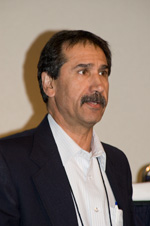Technical Keynote Session 2
Beef Tenderness: Determination, Regulation and Prediction
During one of the 2009 Beef Improvement Federation (BIF) symposium’s technical committee sessions, meat scientist Mohammad Koohmaraie discussed technologies addressing beef tenderness. Formerly a researcher at the U.S. Meat Animal Research Center (USMARC), Clay Center, Neb., Koohmaraie is now associated with IEH Laboratories and Consulting Group, based in Washington state. Koohmaraie said juiciness and flavor intensity of beef certainly matter, but consumer satisfaction really hinges on tenderness. It’s also the most variable factor affecting the beef eating experience.

Mohammad Koohmaraie
Koohmaraie talked about factors contributing to variation in beef tenderness, including genetics, preharvest nongenetic events and postharvest influences. He also summarized research and development of technology aimed at reducing variation in beef tenderness.
With respect to genetics, Koohmaraie said there is little difference in beef tenderness among Bos taurus breeds, but there is considerable variation within any given breed. Research also indicates tenderness decreases linearly with the increase of Bos indicus breed influence. While genetics play a significant role in controlling beef tenderness, Koohmaraie said a large proportion of the variation appears to be attributable to nongenetic factors
“Our work over the years has shown that, by far, 14 days of postmortem storage (aging) greatly influences tenderness,” Koohmaraie stated. “Absolutely nothing is more important to [enhancement of] tenderness than aging beef for 14 days or more.”
The beef industry has long sought technology allowing for accurate prediction of tenderness of beef carcasses. Koohmaraie noted methods utilizing measurement of “shear force” to test tenderness, but such methods require the sacrifice of one steak per carcass. He said the desire for noninvasive technology spurred development at USMARC of a tenderness prediction system based on visible and near-infrared reflectance spectroscopy. The technology, which identifies carcasses with increased likelihood of yielding tender steaks, has been tested in several countries and is commercially available for application in beef packing plants.
Ideally, Koohmaraie said, tenderness information gleaned at the packing plant or retail levels would be shared with the seedstock industry, for its use in addressing tenderness through genetic selection. An economic incentive for improved meat tenderness is required to encourage these activities industry-wide, he added.
“Leaders of the beef packing industry a decade ago decided that beef safety was a noncompetitive issue and any information that improves beef safety should be shared. It had a dramatic effect on improving the safety of U.S. beef,” Koohmaraie said. “I propose that the industry take a similar approach to improving beef tenderness.”
Editor’s Note: This summary was written under contract or by staff of Angus Productions Inc. (API). To request reprint rights contact Shauna Rose Hermel, editor, at 816-383-5270. PowerPoints are posted with permission of the presenter and may not be reproduced in whole or in part without the express permission of the presenter.
The 41st BIF Research Symposium and Annual Meeting was hosted by the California Beef Cattle Improvement Association and the California Cattlemen's Association. For more information, visit www.bifconference.com or www.calcattlemen.org/bif2009.html.



